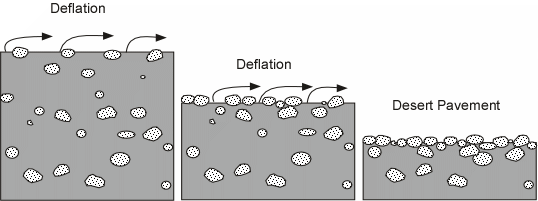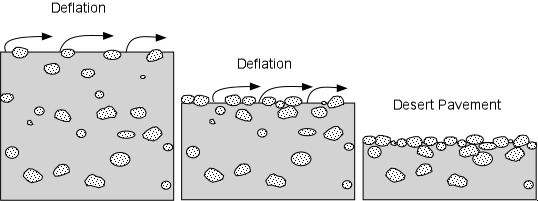Other types of erosion
Table of Contents
Table of Contents
Have you ever wondered how deflation occurs in wind erosion? If so, you’ve come to the right place. Wind erosion is a natural process that can cause significant damage to both natural and man-made structures, and it’s essential to understand how it works to prevent such damage.
Pain points related to draw a diagram showing how deflation occurs in wind erosion
The process of wind erosion can be quite complex, and it’s not always easy to understand. The different forms of erosion can also be confusing, and it can be challenging to differentiate between them. Furthermore, without proper knowledge of wind erosion, it can be challenging to prevent or control it, leading to significant damage in some cases.
Answering the target of draw a diagram showing how deflation occurs in wind erosion
In simple terms, deflation occurs in wind erosion when the wind’s velocity decreases, causing it to drop any loose particles or sediment it has been transporting. This dropping of sediment can lead to landforms such as sand dunes, and it can also cause significant damage to buildings and other structures.
Summary of the article’s main points related to draw a diagram showing how deflation occurs in wind erosion
Wind erosion can cause significant damage if not appropriately managed. Deflation is a crucial process that occurs in wind erosion, leading to the formation of landforms such as sand dunes. Understanding how wind erosion occurs is essential in preventing and controlling it, and it’s vital to differentiate between the different forms of erosion.
The Importance of Understanding Deflation in Wind Erosion
As a geologist, I’ve seen firsthand the damage that wind erosion can cause. One of the essential things to understand about wind erosion is how deflation occurs. Deflation is the process whereby loose particles or sediment get dropped as the wind’s velocity decreases. This process can lead to the formation of sand dunes, which can be both beautiful and destructive.
However, deflation can also cause significant damage to buildings and other structures. Therefore, understanding how deflation occurs is essential in preventing such damage. Proper land management is also essential in controlling wind erosion and preserving our environment.
 The Role of Vegetation in Preventing Deflation
The Role of Vegetation in Preventing Deflation
One way to prevent deflation from occurring is by using vegetation to stabilize the ground. Vegetation can protect the soil from being blown away by the wind, thus preventing deflation. Furthermore, vegetation can also absorb the kinetic energy of the wind, reducing its velocity and preventing it from causing significant damage.
Additionally, land management practices such as crop rotation and cover cropping can help maintain the integrity of the soil, reducing the likelihood of deflation occurring.
 ### The Effects of Deflation on the Environment
### The Effects of Deflation on the Environment
Deflation can have significant impacts on the environment. When loose particles and sediment are blown away by the wind, it can lead to soil degradation and desertification. This process can also reduce the fertility of the land and make it difficult for crops to grow, impacting the livelihoods of people who depend on the land for survival.
Furthermore, deflation can also lead to the formation of sand dunes, which can be beautiful, but also damaging. Sand dunes can shift and move quickly, burying everything in their path, including buildings and other structures.
 Question and Answer
Question and Answer
Q: How can deflation be prevented?
A: Deflation can be prevented by using vegetation to stabilize the soil, rotating crops, using cover crops, and implementing proper land management practices.
Q: Can deflation lead to desertification?
A: Yes, deflation can lead to desertification as it can cause soil degradation and reduce the fertility of the land.
Q: What landforms can be created by deflation?
A: Sand dunes are one of the most common landforms created by deflation.
Q: What are the impacts of deflation on buildings and other structures?
A: Deflation can cause significant damage to buildings and other structures by burying them in loose sediment or causing them to collapse due to erosion.
Conclusion of draw a diagram showing how deflation occurs in wind erosion
Wind erosion is a natural process that can cause significant damage to both natural and man-made structures. Understanding the different forms of erosion, such as deflation, is crucial in preventing and controlling wind erosion. Proper land management practices, including using vegetation, crop rotation, and cover cropping, can help prevent deflation and preserve our environment for future generations.
Gallery
Deserts

Photo Credit by: bing.com / wind deserts sediment deflation process sanelson blown erosion sand deposition bedrock abraded shaped surface stone any been tulane edu
Other Types Of Erosion - Alien’s Guide To Earth

Photo Credit by: bing.com / erosion wind types deflation abrasion transportation particles indiana benchmarking
By Wind - Weathering, Erosion And Deposition

Photo Credit by: bing.com / erosion soil wind weathering soul process deposition january
IAS Preparation- Simplified Like Never Before!: LANDFORMS PRODUCED BY

Photo Credit by: bing.com / deflation wind landforms preparation ias simplified never before particles termed loose removal ground
Wind - Erosion And Deposition

Photo Credit by: bing.com / deflation wind desert erosion diagram deserts science pavement abrasion recession earth winds difference between deposition rocks causes surface above weebly




